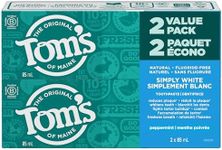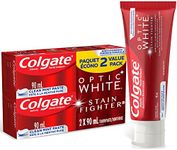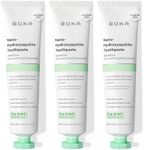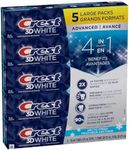Buying Guide for the Best Whitening Toothpastes
Choosing the right whitening toothpaste can make a noticeable difference in your smile and overall oral health. Whitening toothpastes are designed to help remove surface stains from your teeth, making them appear whiter and brighter. However, not all whitening toothpastes are created equal, and the best choice for you depends on your specific needs, sensitivity, and oral care habits. Understanding the key features and ingredients will help you select a toothpaste that is both effective and safe for regular use.Whitening AgentsWhitening agents are the active ingredients in toothpaste that help remove stains and lighten the color of your teeth. Common agents include hydrogen peroxide, carbamide peroxide, and mild abrasives like baking soda. Hydrogen peroxide and carbamide peroxide chemically break down stains, while abrasives physically scrub them away. If you want quick results, a toothpaste with peroxide may be more effective, but if you have sensitive teeth, a milder abrasive might be better. Consider your sensitivity and how much whitening you need when choosing the right agent.
Abrasiveness (RDA Value)Abrasiveness refers to how much the toothpaste can physically scrub stains off your teeth, measured by the Relative Dentin Abrasivity (RDA) value. Low RDA values are gentle and suitable for people with sensitive teeth or gums, while higher RDA values can remove more stubborn stains but may wear down enamel over time. If you have healthy, strong teeth and want maximum stain removal, a higher RDA might be fine. If you have sensitivity or thin enamel, look for a toothpaste with a lower RDA.
Fluoride ContentFluoride is a mineral that helps strengthen tooth enamel and prevent cavities. Most whitening toothpastes contain fluoride, but the amount can vary. If you are prone to cavities or want to maintain strong teeth while whitening, make sure your toothpaste contains fluoride. If you already use other fluoride products or have been advised to limit fluoride, you might opt for a lower-fluoride option.
Sensitivity ProtectionSome whitening toothpastes include ingredients like potassium nitrate or stannous fluoride to help reduce tooth sensitivity. If you often experience discomfort when eating hot or cold foods, look for a toothpaste that offers sensitivity protection. This can help you achieve a whiter smile without causing pain or discomfort.
Flavor and TextureFlavor and texture can affect how pleasant it is to use a toothpaste daily. Whitening toothpastes come in a variety of flavors, from classic mint to more unique options. Texture can range from smooth gels to gritty pastes. If you dislike strong flavors or gritty textures, look for a toothpaste that matches your preferences, as this will encourage regular use and better results.
Enamel ProtectionEnamel protection refers to how well the toothpaste helps maintain the strength and integrity of your tooth enamel while whitening. Some formulas include ingredients that help remineralize enamel or reduce the risk of enamel erosion. If you are concerned about enamel wear, especially with frequent whitening, choose a toothpaste that specifically mentions enamel protection.




















